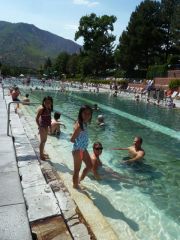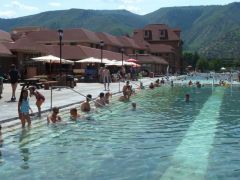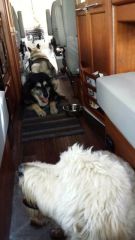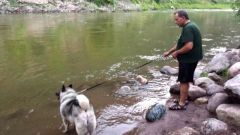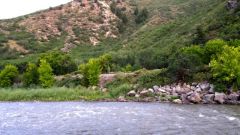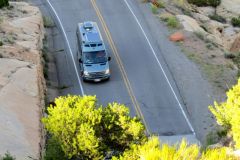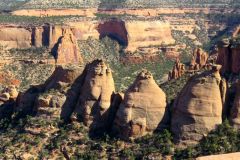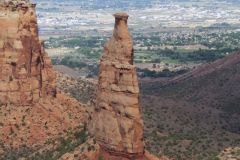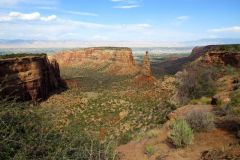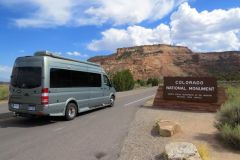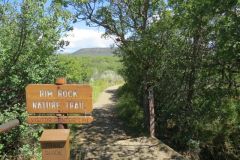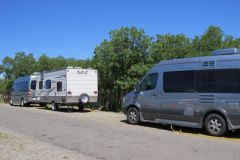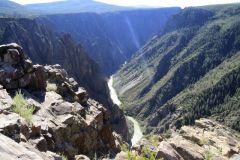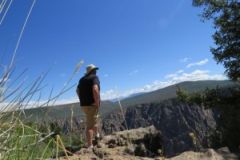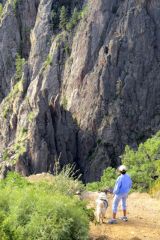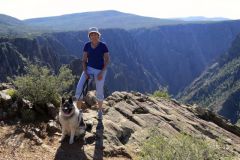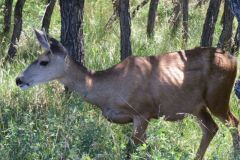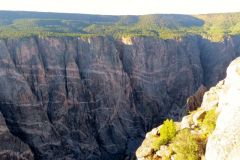-
Content Count
669 -
Joined
-
Last visited
-
Days Won
17
Content Type
Profiles
Forums
Blogs
Gallery
Everything posted by Roadtrekingmike
-
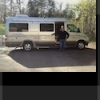
Rocky Mountain High in the Rocky Mountain National Park
Roadtrekingmike posted a blog entry in Roadtreking Blog
I now understand what John Denver meant by his song: I’ve now been Rocky Mountain High. And like Denver, who penned the song shortly after moving to Aspen to celebrate his love for his new state and the awe-inspiring mountains, Colorado’s Rocky Mountain National Park made me want to sing, too. If I could only have caught my breath. For there, somewhere well above 12,000 feet, a quarter mile up a tundra bordered trail from an overlook off Trail Ridge Road , were three Bighorn Sheep, standing like sentinels and looking out at the same snow covered peaks that I was. I zoomed in for a closeup with my new telephoto and felt so at one with them, the mountains and the whole Colorado experience we had been living the past two weeks that, had Jennifer asked, I would have gladly sold my Michigan home and moved there. Immediately. Fortunately, she didn’t ask. At that altitude, she, too was having trouble catching her breath. But trust me, if you’ve never stood on top of a mountaintop in Colorado, you have no idea what you were missing. Go listen to Denver’s Rocky Mountain High, which, is, by the way, one of Colorado’s two official state songs. The other one, to save you asking, is Where the Columbines Grow. And they also grow in those Rocky Mountains. But Denver’s line in the song about “coming home to a place he’d never been before” is exactly what the Rocky Mountains made me feel. You just want to stare and stare at them. Breathing the clean, cool air and watching the sun and shadows move up and down the mountains. We came into the park from Estes Park., on the east end, and like lots of other people, took Trail Ridge Road up and through the 415 square mile park. That was our only complaint. There were way too many people. And half or more of those we sw were from somewhere other than the United States. Our favorite was a group of some 30 motorcyclists from the Netherlands, riding rented Harleys. Trail Ridge Road has been dubbed the “highway to the sky” and it is, in just about every book of best drives you’ll find, in the Top 10. It winds 48 miles between Estes Park on the park’s east side and Grand Lake on the west. Eleven miles of the highway travel above treeline, the elevation near 11,500 feet where the park’s evergreen forests come to a halt. As it winds across the tundra’s vastness to its high point at 12,183 feet elevation (where we saw the Bighorn Sheep) , Trail Ridge Road (U.S. 34) offers visitors thrilling views, wildlife sightings and spectacular alpine wildflower exhibitions, all from the comfort of their car. I loaded up everyone in our Roadtrek – four adults, two kids and two dogs – and we had no problems on the road. But almost every overlook has a path or hiking trail running up or down or out into the wilderness. Besides the sheep, we also saw several herds of elk. There were traffic jams around every overlook. But as we lingered and the day wore on, the crowds seemed to thin. By the time we stopped to picnic at Lily Lake, it was much less congested. We would have loved to camp at one of the four campgrounds in the park but even six weeks out, we were unable to get a reservation. The only place around where we could get space was at the KOA in Estes Park. What a disaster that was. At $56 a night, our “campsite” was on the side of a gravel road, hard up against a berm and maybe 10 feet from those Kamping Kabins that KOA also rents out. It was one of the worst campsites we have ever experienced. Dusty, crowded and more like a parking lot than a campground, we were miserable. ven the spots not on the road/parking lot were very close together. We witnessed a near fistfight when the smoke from one camper’s cigar riled up his neighbor. I complained to the owner and he acknowledged that I wasn’t the first who got stuck with one of those side of the gravel road spots. But he candidly explained that if he were to do away with those roadside spots his profit would drop by $20,000 a year and, for that price, he could live with the complaints. Eating out on the picnic table was like eating in a dust bowl. The kids had no place to play outside the RVs except the street, or way down and around in the small playground. The dogs had to lie in the dirt. You couldn’t open the RV windows without dust coming in. We had no other choices. Every other campground in the area was booked up. We arrived on a Friday night and gathered everyone up in the Roadtrek and headed to a nearby city park, where we found picnic tables and set up a grill. On Saturday, after touring the park, we walked around Estes Park until dark. Anything to avoid spending time at the KOA. Wendy, Dan and the girls went horseback riding into the foothills of the Rockies. I did enjoy an impromptu visit from two readers of this blog, Sarah and Tim, who live in Estes park and saw that we were in their area. They drove up and down the KOA streets until they found where we were parked. We talked about Colorado and, specifically, winter in the Rocky Mountain National Park. Tim, who is a curator at the museum there, told me that in the spring, when Trail Ridge Road is plowed out, it is not unusual to have them bordered by 35 foot tall snowdrifts. It snows every month in the park. Even August. Back to the Rocky Mountain High theme. If you are planning to visit the Rocky Mountain National Park and you are a flatlander, not used to altitude, give yourself some time to get acclimated. Start at lower altitudes and slowly work up. Elevation is an integral part of the park experience. The park is all above 7,500 feet, so don’t do strenuous activities until your system has adjusted. Even driving at high elevation can affect sensitive individuals. Just ask my daughter, Wendy. Altitude sickness symptoms include shortness of breath, fatigue, dizziness, nausea, rapid heartbeat and insomnia. All of us in our family group felt at least one of those symptoms. Drink lots of water and if the symptoms are severe, persist, depart for lower elevation. But most of the symptoms ease after a couple of days of acclimation. But if they don’t, you will be so awestruck by the beautiful scenery, that you forget about them. -
From the album: Glenwood Springs, Colo., and Colorado River camping
Our spot at the Glenwood Canyon Resort and RV Park. Because we shared a spot, we were up top with the big rigs. We wish we had taken two smaller spots on the lower area along the Colorado River. -

Glenwood Springs, Colo., and Colorado River camping
Roadtrekingmike added images to a gallery album in Members Gallery
-
From the album: Glenwood Springs, Colo., and Colorado River camping
Rachel and Hua Hua (standing) with Aimee and Jeff (in the water) -
From the album: Glenwood Springs, Colo., and Colorado River camping
Granddaughter Hua Hua,10, and Rachel, 7, heading into the world’s largest hot springs pool. -
From the album: Glenwood Springs, Colo., and Colorado River camping
Tai, Sequoia and Charlie in our Roadtrek as everyone else (except Jennifer and me, the official dog sitters) swam. Whine. Whine. -
From the album: Glenwood Springs, Colo., and Colorado River camping
Tai loved the river, too. -
From the album: Glenwood Springs, Colo., and Colorado River camping
The Colorado River -

Glenwood Springs, Colo., and Colorado River camping
Roadtrekingmike posted a blog entry in Roadtreking Blog
One of the things about traveling by RV that makes it so much fun is the serendipity, the unscheduled things that you just happen upon and, in the moment, take advantage of because, with an RV, you can. Such was the town of Glenwood Springs along I-70 180 miles west of Denver, home of the world’s largest hot springs pool. The hot mineral water has been drawing visitors from all over the world since 1888, when a resort and original spa officially opened for business. But even before that, the Ute Indians made yearly pilgrimages to the springs which they considered to be sacred. lenwood Springs was originally known as “Defiance”. Defiance was established in 1883, a camp of tents, saloons, and brothels with an increasing amount of cabins and lodging establishments. It was populated with the expected crowd of gamblers, gunslingers and prostitutes. Wild West legend Doc Holliday of the Gunfight at the OK Coral fame spent the final months of his life in Glenwood Springs and is buried in the town’s original Pioneer Cemetery. Suffering from tuberculosis, he hoped the healing waters would extend his life. President Teddy Roosevelt spent an entire summer vacation living out of the historic Hotel Colorado near the springs. Today, the hot springs have been turned into a community swimming pool. For$18, you can spend the day in it. The big pool is the size of a football field and is 90 – 93 degrees Fahrenheit, all year long. A smaller therapy pool is between 102 and 104 degrees Fahrenheit and has bubble chairs and submerged marble benches. There are two water slides and a kiddie pool. As the kids, in laws and grandkids swam in the hot springs pool, Jennifer and I dog sat Tai, Sequoia and Charlie in our Roadtrek eTrek, running the air conditioner full blast in the parking lot. It was a tight squeeze. The outside temperature was in the low nineties. It was in Glenwood Springs after the hot springs swim that we said goodbye to Jeff and Aimee, who had to return to Michigan for their jobs a little earlier than the rest of us. Daughter Wendy and Dan Bowyer and granddaughters Hua Hua and Rachel remained with us, staying in the 21 foot travel trailer we are hauling with our Roadtrek. We overnighted at the Glenwood Canyon Resort RV Park, located right off the next exit east from the spa on I-70. A spot with full hookup cost us some big bucks. There is a $54 campsite fee that covers two people, and then they charge $5 for every other person over five years of age and $5 per dog. Our total bill was $84, plus tax. Yikes. This is a pretty ritzy area and the even the camping fees reflect it. But it is also a resort with deluxe cabins, white water rafting, zip lines and a nice restaurant/bar. Best of all, the resort and it’s RV park is right on the Colorado River, surrounded by towering canyon walls. Tenters, Class B and C RV owners will want to take spots on the lower level, along the river, which flows white water fast ten feet away from your spot. When we checked in at the front desk, I noticed a bunch of earplugs, free for campers. “For the river noise?” I asked, amazed that someone wouldn’t like the sound of rushing water. “No, the trains,” answered the clerk. Right on the opposite side of the river is a railroad track that, during our stay, carried three high speed trains in the middle of the night. Mercifully, they don’t sound their horns. But the noise would definitely wake all but a very sound sleeper. The river is a great place to fish. A young boy from Texas had a stringer full of large rainbow trout. We walked down to it at night and sat on a picnic table, mesmerized by the swift water flowing past, sparking like diamonds in fading rays of the setting sun. Jen and I had planned on unhitching the trailer and going back to the hot springs to swim, leaving Tai with the with rest of the family. But the canyon RV campsite was so alluring and the river so strong a draw that we just stayed and stared at the beauty of the place. We spent just one night in the area. Though unplanned for us, it was a great decision. If you’re coming this way, plan it. You may even want to spend two nights. -

Colorado National Monument: Not what you'd think
Roadtrekingmike added images to a gallery album in Members Gallery
-
From the album: Colorado National Monument: Not what you'd think
On the road again in Roadtrek -
From the album: Colorado National Monument: Not what you'd think
Colorado National Monument -
From the album: Colorado National Monument: Not what you'd think
Colorado National Monument -
From the album: Colorado National Monument: Not what you'd think
Mike and Jennifer Wendland, Rachel, Dan, Hua Hua and Wendy Bowyer, Jeff and Aimee Wendland, and our dogs, Tai, Charlie and Sequoia at the Colorado National Monument -
From the album: Colorado National Monument: Not what you'd think
Colorado National Monument -
From the album: Colorado National Monument: Not what you'd think
Colorado National Monument -
From the album: Colorado National Monument: Not what you'd think
Entering Colorado National Monument -

Colorado National Monument: Not what you’d think
Roadtrekingmike posted a blog entry in Roadtreking Blog
Quick now, when I say we visited the Colorado National Monument, what did you think? Unless you’ve been here and seen it, I bet you thought is was a statue of some sort, didn’t you? I know I did when my daughter, Wendy, first insisted we include it in our list of ”must sees” during our Great Roadtreking Family Vacation of 2013. The monument is not what we expected. It is nothing short of stupendously beautiful, a long stretch of spectacular rock monotliths cut deep into the sandstone and even granite rock formations that make for sheer-walled, red rock canyons following the undulating twists and turns of the Rim Rock Drive that traverses up and down and through the preserve for 24 miles. That’s what the Colorado National Monument really is – a preserve, located just west of Grand Junction, CO and south of the mountain bike mecca of Fruita. It offers panoramic views of towering red rock structures with almost two dozen spots to pull over for photos. There are also lots of hiking trails. We stayed in the James M Robb -Colorado River State Park a quarter mile south of I-70 at the Fruita exit. The park has five sections, but only the Fruita section and the the Island Acres location 15 miles to the west offer camping The National Monument is another half mile down the road. There is also a great dinosaur museum nearby. t takes about two hours to see the major sights on the monument drive, though three hours is probably a better minimum amount of time to devote to your tour. There is an 80 site campground on the monument grounds, though there are no electric or water hookups, something my newbie son and daughter and their families need their first time out. If it were just Jennifer and me, we would have stayed up in the campground. But we have no complaints about Colorado State Parks. We’ve been very impressed with the ones we have stayed at. We did our drive through the monument in a mid afternoon. Then we found a great Mexican restaurant in Fruita with an outdoor patio that let all off us eat there with the dogs tied up at our feet, under the table. Usually, we have to take turns babysitting the dogs and one or two of us have to stay in our air conditioned Roadtrek while the others shop or eat. So it was a real treat to all be able to eat out together. So know we know: The Colorado National Monument is not a statue. It is a place, run by the U.S. Parks Service just like a National Park. If I had my way, I’d give it a new name: I’d call it the Colorado National Treasure. -
-
From the album: The Black Canyon of the Gunnison
The Rim Rock Trail right off the campground is a great hike with spectacular views. -
From the album: The Black Canyon of the Gunnison
Our campsites along Loop B. That’s our Roadtrek eTrek at far left, which pulled the AmerLite Travel Trailer that my daughter Wendy, son-in -aw Dan Bowyer and granddaughters Hua Hua and Rachel used. At far right is the borrowed Roadtrek SS Ideal used by my by son, Jeff, and his wife, Aimee. -
From the album: The Black Canyon of the Gunnison
The Black Canyon of the Gunnison -
From the album: The Black Canyon of the Gunnison
That’s me staring and staring at the majesty of the place. You can get right up close, with no guard rails between you and a sheer cliff that drops as much as 2,000 feet to the canyon floor. -
From the album: The Black Canyon of the Gunnison
Jennifer and Tai near the Pulpit Rock overlook -
From the album: The Black Canyon of the Gunnison
You can take dogs on the Rim Rock Trail. Here’s Jennifer and Tai.



